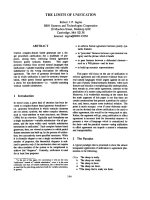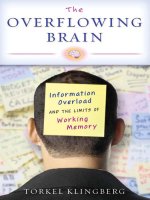- Trang chủ >>
- Khoa Học Tự Nhiên >>
- Vật lý
the overflowing brain information overload and the limits of working memory nov 2008
Bạn đang xem bản rút gọn của tài liệu. Xem và tải ngay bản đầy đủ của tài liệu tại đây (1.29 MB, 217 trang )
The Overflowing Brain
This page intentionally left blank
The Overfl owing Brain
Information Overload and the
Limits of Working Memory
Torkel Klingberg, MD, PhD
Professor of Cognitive Neuroscience
Karolinska Institute
Stockholm Brain Institute
Stockholm, Sweden
Translated by Neil Betteridge
1
2009
1
Oxford University Press, Inc., publishes works that further
Oxford University’s objective of excellence
in research, scholarship, and education.
Oxford New York
Auckland Cape Town Dar es Salaam Hong Kong Karachi
Kuala Lumpur Madrid Melbourne Mexico City Nairobi
New Delhi Shanghai Taipei Toronto
With offi ces in
Argentina Austria Brazil Chile Czech Republic France Greece
Guatemala Hungary Italy Japan Poland Portugal Singapore
South Korea Switzerland Thailand Turkey Ukraine Vietnam
Copyright © 2009 by Torkel Klingberg
Published by Oxford University Press, Inc.
198 Madison Avenue, New York, New York 10016
www.oup.com
Oxford is a registered trademark of Oxford University Press
All rights reserved. No part of this publication may be reproduced,
stored in a retrieval system, or transmitted, in any form or by any means,
electronic, mechanical, photocopying, recording, or otherwise,
without the prior permission of Oxford University Press.
Library of Congress Cataloging-in-Publication Data
Klingberg, Torkel, 1967-
[Översvämmade hjärnan]
The overfl owing brain: information overload and the limits of working
memory / Torkel Klingberg.
p. ; cm.
Includes bibliographical references and index.
ISBN: 978-0-19-537288-5
1. Human information processing—Physiological aspects. 2. Short-term
memory—Physiological aspects. 3. Attention—Physiological aspects.
4. Cerebral cortex—Growth. 5. Neuroplasticity. I. Title.
[DNLM: 1. Memory. 2. Attention. 3. Memory Disorders—pathology.
4. Neuronal Plasticity—physiology. BF 371 K654o 2009]
BF444. K5513 2009
153—dc22
2008014273
9 8 7 6 5 4 3 2 1
Printed in the United States of America
on acid-free paper
To Hannah and Linnea
This page intentionally left blank
vii
I would like to thank all my friends and colleagues who
have read, commented upon, and discussed the early drafts
of this book. Thanks also to Tobias Nordqvist, my editor at
Natur och Kultur, who gave me much constructive feed-
back, and Lena Forssén and Lotte Mjöberg at Natur och
Kultur. Jan-Eric Gustafsson and Magnus Enquist provided
valuable comments on the sections on intelligence and evo-
lution, respectively.
For the English translation of the book I am grateful of
the excellent work of Neil Betteridge. I would like to thank
Elkhonon Goldberg for his kind foreword, and to the peo-
ple at Oxford University Press who helped with the English
edition: Craig Panner, David D’Addona, and Sue Warga.
Finally, thanks to my mother and father, to Anna-Karin
for all the support, and to Hannah and Linnea for the inspi-
ration they give me.
Acknowledgments ■
This page intentionally left blank
ix
Midtown Manhattan has never been a tranquil place, but
over the last decade or so its rhythm has reached a new
level of frenzy. Cell phones and iPods have arrived with a
vengeance! Have they provided the infl exion point on soci-
ety’s path to self-destruction? People are listening, talking,
texting, taking pictures, all while trying not to bump into
one another with mixed success. It is an everyday occur-
rence to see people tripping over one another, over inani-
mate objects, over dogs, stumbling, slipping, falling, bump-
ing into walls, nearly run over by cars—while clinging to
their cell phones.
While the image of a befuddled pedestrian exceeding
his or her capacity for multitasking by having one gadget
too many can be hilarious, it is emblematic of our times and
of the general challenges facing our culture. We are increas-
ingly driven by information fl ows, and while politicians
and economists worry about an insuffi cient fl ow of oil to
keep our society going, we should be equally concerned
Foreword ■
about an increasingly excessive and overlapping fl ow of
information that leaves the average member of our species
increasingly distracted and disoriented.
How much multitasking can an average human being en-
gage in without being run over by a car or by a fellow
citizen? Has our culture reached, or perhaps exceeded, the ca-
pacity of the brain, which evolved from a far more sedate
world? Are there limits to the human capacity for multi-tasking
and for parallel processing? Can these limits be rigorously
studied? Can they be expanded by training our brains?
Very few people are in a better position to address these
questions than Torkel Klingberg. Dr. Klingberg has studied
and conducted important research both in Sweden and in
the United States, and he stands out among his colleagues
by his ability to combine cutting-edge basic research in
cognitive neuroscience with an eye for the potential of the
results for patients and in every day life. Dr. Klingberg is
Professor of Cognitive Neuroscience at the famed Karolin-
ska Institute in Stockholm, where he spearheads a large re-
search program using state-of-the-art technologies like
functional magnetic resonance imaging (fMRI) and diffu-
sion tensor imaging (DTI), as well as neural-network model-
ing, to elucidate the mechanisms of executive functions, at-
tention, and of the various ways in which they may become
aberrant in development. His research has also resulted in a
method for cognitive rehabilitation through training of
working memory, a method now in use both in Europe and
the United States.
The brain is very much in vogue. Over the last few
years popular books about the brain have become a liter-
ary genre in and of itself. The Overfl owing Brain stands out
among these books owing to its breadth, lucidity, and to its
engaging narrative. The book fi rst appeared in Swedish in
2007 and was met with great success. This is the fi rst gen-
eral-interest book in English which covers a comparable
range of topics at a comparably authoritative level and
x foreword
foreword xi
with a comparable quality of writing. This makes the
English-language edition of The Overfl owing Brain particu-
larly welcome and timely.
With effortless virtuosity, Klingberg interweaves the
discussion of evolution, history of neuroscience, cutting-
edge research methodologies, information theory, recent
insights into neuroplasticity, and a thoughtful review of
various neurodevelopmental disorders in order to better
explain our “overfl owing brain.” While many of the “brain
books” for the general public are written by professional
journalists and science writers purveying second-hand
knowledge of cognitive neuroscience, Klingberg’s book is
authoritative, having the advantage of being written by a
true leader of the fi eld. Klingberg does not pull any
punches: He gives the reader the proper respect by being
precise and substantive, without diluting the narrative with
vacuous cuticisms so common, unfortunately, in “trade
books.” At the same time, what makes The Overfl owing
Brain particularly remarkable is its literary seamlessness
that would make a professional science writer proud. This
unique combination of substance and form will make the
book valuable both for the educated general public as a
high-level “trade book,” and for the professional audience,
perhaps even as a secondary text for students.
Like most fi elds of human endeavor, cognitive neuro-
science and clinical neuropsychology has its fads. As is of-
ten the case, trendy notions rapidly become diffuse, opaque,
infl ated, and devoid of clear content. “Working memory”
was a pioneering concept introduced by leading neurosci-
entists like Alan Baddeley and Patricia Goldman-Rakic, but
it has since become a fad with all the untoward conse-
quences thereof. Klingberg makes a particularly valuable
contribution by restoring scientifi c rigor and clarity to the
concept of “working memory.” This is one of the many
qualities that make The Overfl owing Brain invaluable both
for the general public and for the professional audience.
Attention Defi cit Hyperactivity Disorder (ADHD) is
another example of an originally valuable and meaningful
concept having been diluted and infl ated beyond recogni-
tion, scientifi c merit, or clinical legitimacy. Here, too, Kling-
berg provides an invaluable service both to the profession
and to the general public by judiciously rendering ADHD
with admirable rigor and clarity.
It has been said that “familiarity breeds contempt.”
Familiarity also breeds the illusion of understanding. The
notion of Intelligence Quotient (IQ) has been part of the
mainstream culture for so long that it is common among
the members of the general public to invoke it with the ca-
sual aura of comprehension. In reality, however, very few
members of the general public can offer an accurate defi ni-
tion of IQ if asked. Klingberg does a marvelous job explain-
ing it and putting it into a rigorous neuroscientifi c and
social-scientifi c context.
The Overfl owing Brain is rich in insights and informa-
tion—too many to review them all in this brief introduc-
tion. This is a truly remarkable book that will be read and
enjoyed by members of the general public and the profes-
sional audience alike.
Elkhonon Goldberg
New York
May 2008
xii foreword
xiii
1. Introduction: The Stone Age Brain Meets
the Information Flood 3
2. The Information Portal 19
3. The Mental Workbench 33
4. Models of Working Memory 45
5. The Brain and the Magical Number Seven 55
6. Simultaneous Capacity and Mental Bandwidth 69
7. Wallace’s Paradox 83
8. Brain Plasticity 93
9. Does ADHD Exist? 103
10. A Cognitive Gym 115
11. The Everyday Exercising of Our Mental
Muscles 125
12. Computer Games 137
Contents ■
13. The Flynn Effect 147
14. Neurocognitive Enhancement 157
15. The Information Flood and Flow 163
Notes and References 171
Index 197
xiv contents
The Overflowing Brain
This page intentionally left blank
3
You’ve just entered a room, probably to fetch something,
but you’re not that sure, for you’re staring at the wall try-
ing to remember what it was you were going to do. The in-
struction to yourself that you had in your head only a mo-
ment ago has vanished. Maybe you were distracted by
your cell phone? Perhaps you were trying to do two or
three things at the same time? Whatever, the outcome was
a surplus of information in your brain that left you stand-
ing there gazing blankly at the wall.
Our brains have limited capacity for processing infor-
mation. This book is an attempt to understand why this is
so, what effect it has on our everyday lives, and how we
can stretch these limits with mental exercise.
As advances in information technology and communi-
cation supply us with information at an ever accelerating
rate, the limitations of our brains become all the more obvi-
ous. Boundaries are defi ned no longer by technology but
by our own biology. These developments are particularly
1 ■
Introduction: The Stone Age Brain
Meets the Information Flood
4 introduction
noticeable in our increasingly complex offi ces. Let us, by
way of example, consider Linda, a fi ctional person who’s
nonetheless based on a close friend of mine and who has a
work situation that will no doubt be familiar to many of us.
Linda is project manager at an IT company. Her Mon-
day mornings start at half past eight as she seats herself at
her desk in her open-plan offi ce. With her cup of coffee at
her side, she starts going through the weekend’s crop of
e-mails. She decides which are to be dumped, which are to
be read but not dealt with, which should be responded to
immediately, and which will end up as yet another item on
her to-do list, which she updates and reprioritizes on her
PC and then synchronizes with her BlackBerry. Come ten
o’clock, she still hasn’t got through her e-mails but decides
to tackle the fi rst item on her to-do list: write a report and
read through four of her employees’ progress reports.
Three minutes into her report, she gets interrupted by a
colleague who needs the go-ahead on a computer pur-
chase. They log on to the computer company’s Web site to
take a quick look at the options available, but they’re inter-
rupted by a phone call to Linda about an e-mail from last
Friday. The call goes on and on, and her colleague returns
to his desk while Linda tries to ignore the signals from her
cell phone as she frantically searches for the e-mail that the
call’s about. As she listens she takes the opportunity, while
she has the e-mail program up, to delete some spam.
Thus the modern offi ce. A survey of workplaces in the
United States found that the personnel were interrupted
and distracted roughly every three minutes and that peo-
ple working on a computer had on average eight windows
open at the same time. In his article “Overloaded Circuits:
Why Smart People Underperform,” psychiatrist Edward
Hallowell coins the term “attention defi cit trait” to charac-
terize the situation in which Linda and many others fi nd
themselves. This is not a new diagnosis of any use to doctors,
but rather a description of the mental state that information
introduction 5
technology, a faster pace, and changing work patterns have
induced. Some would call it a lifestyle. But the term “atten-
tion defi cit trait” has been chosen for its similarity with the
term “attention defi cit disorder” (ADD), which is a variant
of attention defi cit hyperactivity disorder (ADHD) without
the hyperactivity (more about ADHD later). The diagnosis
is defi ned by a string of symptoms such as “diffi culty sus-
taining attention,” “diffi culty organizing tasks or activities,”
“easily distracted by extraneous stimuli,” and “forgetful in
daily activities.” Often these diffi culties are so serious that
they prevent people from doing their jobs properly or re-
quire medication. The point of Hallowell’s term is that it il-
lustrates how the modern work situation, with its pace and
simultaneous demands, often gives us the feeling of having
attention diffi culties and of not quite having the capacity to
do our jobs. Our brains are being fl ooded. But is it really the
case that the information society generally impairs people’s
attentional abilities? What are attentional abilities, anyway,
and exactly what in our complex work situations is mentally
demanding?
One demand factor in our working lives is the inces-
sant distractions: all the impressions that buzz around us
like mosquitoes and make it hard for us to concentrate on
what we’re doing. The torrent of information increases not
only the volume of data we’re expected to take in but also
the volume we need to shut out. One example of a change
in the degree of distraction is in the transformation of a tra-
ditional offi ce into an open-plan one. Such a rearrangement
might improve communication between employees and be
more stimulating, but it also gives us a greater infl ux of im-
pressions in the shape of ringing phones, chatter, and SMS
signals that we have to try to ignore. Another example of
increasing demands is the way we source more and more
information from the Internet instead of books or newspa-
pers. It’s usually perfectly possible to read an article in a news-
paper without being distracted by advertisements in the
6 introduction
margin; reading articles on the Internet, their margins packed
with little animated advertisements, presents more of a
challenge, however. What is it in our brains that determines
whether we can concentrate and ignore the distractions?
Multitasking is the quick and easy solution for all those
who want to get more done in less time. However, doing
(or at least trying to do) several tasks simultaneously is one
of our most demanding everyday activities. Running on a
treadmill while watching TV usually isn’t too taxing, nor is
chewing gum while walking in a straight line. But even
such a mundane situation as talking on a cell phone while
driving is not as easy as we’d like to think. Apart from the
fact that it’s diffi cult to hold the wheel and shift gears with
the same hand, or to keep our eyes on the road and on the
phone’s display at the same time, there’s something in the
mentally demanding task of telephoning that makes us
worse drivers. Tests show that people who drive while per-
forming a mentally demanding task have a reaction time
that is up to one and a half seconds slower. Why can’t we
combine some activities with others? Why is the brain
sometimes unable to do two things at once?
The issue of simultaneous performance is particularly
interesting right now, as technological progress seems to
encourage or indeed even require it. Thanks to the wireless
revolution, we can take technology pretty much anywhere
we want to. We chat on the phone while walking, driving,
or watching television. We can have little displays in our
cars showing maps that are continually updated and direct
us as we drive. While in meetings we can text people or
read e-mails on our BlackBerry. When the day is done and
we’re sitting in front of our television, a simultaneous
scrolling line of text feeds us with extra information; some
TV sets let us watch one channel inserted into another. We
can sit on the sofa with our laptop while watching televi-
sion, wirelessly connected to the Internet.
introduction 7
Our relationship to information is ambivalent. We
clearly often seek out more, quicker, and more complex in-
formation, as if we’re getting a kick from the shot. But
when we’re sitting on the sofa trying to read the on-screen
text while trying to follow the headlines, many of us are
struck with a feeling of inadequacy, with a sense that our
brain is already full of information. It’s overfl owing.
New fi ndings in psychology and brain research suggest
that the diffi culties we fi nd with simultaneous performance
and distractions converge onto one central limitation: the
ability to retain information. When you’re trying to do two
things at once, you have to juggle two different sets of in-
structions in your head. This is double the amount of infor-
mation relative to if you only had one instruction. When
you’re distracted, you often end up losing the original in-
formation, which leaves you standing in a room without
knowing what you’re doing there.
Our limited ability to retain information can be illus-
trated with two situations in which the volume of informa-
tion increases. If you’re given directions of the “Go straight
ahead for two blocks and then left one block” kind, you’ll
probably have no trouble remembering them. However, if
the description is more like “Go straight ahead for two
blocks and then one block to the left and the right again for
three blocks, then left and then three right, and you’re
there,” your chances of getting lost start to increase. It is
too much information. Similarly, a four-digit PIN is quite
easy to remember once you’ve heard it, but a twelve-digit
OCR code is almost impossible to keep in your head.
■ The Magical Number Seven
“My problem, ladies and gentlemen, is that I have been
persecuted by an integer.” Thus began George Miller in
8 introduction
his 1956 article “The Magical Number Seven, Plus or Mi-
nus Two: Some Limits on Our Capacity for Processing In-
formation.” The hypothesis contained within is that there
is a fi xed capacity for the human ability to receive informa-
tion, and that this limit lies at around seven items. There is,
in other words, an inherent constraint on the brain’s band-
width. The article proved to be one of the most infl uential
in twentieth-century psychology.
By the mid-1950s, when Miller wrote his article, there
was a surge in interest in the term information in psychol-
ogy. Scientists had started developing computers during
World War II to help them crack enemy codes. Mathemati-
cians and physicists proposed ways of quantifying the con-
cept of information and examining the limitations of con-
veying information on the phone down copper wires from
one person to another. Miller’s idea was that psychologists
could look at the human brain in exactly the same way as
physicists looked at copper wires. The brain was a “com-
munication channel” of measurable speed, not unlike In-
ternet hookups that let only a certain amount of informa-
tion through per unit of time.
The crux of Miller’s article is that there are limits to our
brain’s capacity. The number seven, he points out, pops up
with uncanny frequency and has the power to stimulate
the imagination, as Miller describes at the end: “What
about the seven wonders of the world, the seven seas, the
seven deadly sins, the seven daughters of Atlas in the Ple-
iades, the seven ages of man, the seven levels of hell, the
seven primary colours, the seven notes of the musical scale,
and the seven days of the week?”
Miller’s idea is illustrated in Figure 1.1, where the x-
axis gives the amount of information received and the y-
axis how much information is reproduced correctly. Take,
for example, a test in which you are asked to repeat a string
of numbers read out to you. The y-axis shows how many
numbers you repeat correctly. If you hear two numbers,
introduction 9
you can easily remember them and tap them into a keyboard.
You are on the straight part of the graph, where informa-
tion input is the same as output. But if you are asked to
repeat twelve numbers, or twenty, you will probably be
able to tap in only seven of them correctly. You are now on
the part of the graph where the curve bends under the con-
fi nes of your capacity. Your copper wires just can’t take any
more.
Half a century after Miller published his article, we fi nd
ourselves in something of an information renaissance.
Computerization, which was still in its cradle in the early
1950s, has exploded into every nook and cranny of our so-
cieties, cultures, and lifestyles. Information technology is
now starting to present us with such a surplus of informa-
tion per unit of time that the capacity limitations of our
brains, what Miller calls the “channel capacity,” has be-
come a very real matter for our daily lives.
Capacity threshold
Input (volume of information presented)
Output (volume of information correctly reproduced)
Figure 1-1
Illustration of capacity restrains of the human brain (from Miller, 1956).
10 introduction
■ The Stone Age Brain
If we have an inherent limitation to our ability to handle
information, Miller’s inbuilt mental bandwidth, it is proba-
bly hundreds of thousands of years old. Anatomically
modern Homo sapiens evolved some 200,000 years ago in
Africa. Geneticists have shown that every living human
has DNA from one and the same woman, humanity’s Eve,
who lived at some point between 150,000 and 200,000 years
ago. Homo sapiens then dispersed out into the world, in-
cluding to southern Europe, where they gradually dis-
placed their contemporaries the Neanderthals. Early peo-
ple here left behind magnifi cent cave paintings, such as
those in the cave of Cro-Magnon in southern France, which
lent its name to this modern type of Homo sapiens.
Cro-Magnonshad the same brain volume and anatomy
as we have today and if we were to dress one up in mod-
ern clothes, he would raise few eyebrows as he walked the
streets of a modern city.
Cro-Magnon humans lived a leisurely life as hunters
and gatherers, probably spending most of their days in
groups of a few families, possibly fi fty individuals. Occa-
sionally the clan, a larger grouping of roughly 150 related
individuals, would gather. Most of their time was probably
devoted to collecting and preparing food, preparing skins,
making tools, and going on the odd hunt. The technologi-
cal environment in which Cro-Magnons lived consisted of
a mere handful of tools, such as arrowheads, needles, and
bone hooks.
The brains with which we are born today are almost
identical to those with which Cro-Magnons were born forty
thousand years ago. If there is some inherent limitation to
our ability to handle information, it should be present al-
ready at this time, when the most technologically advanced
artifact was the barbed bone harpoon. The same brain now
has to take on the torrent of information that the digital









